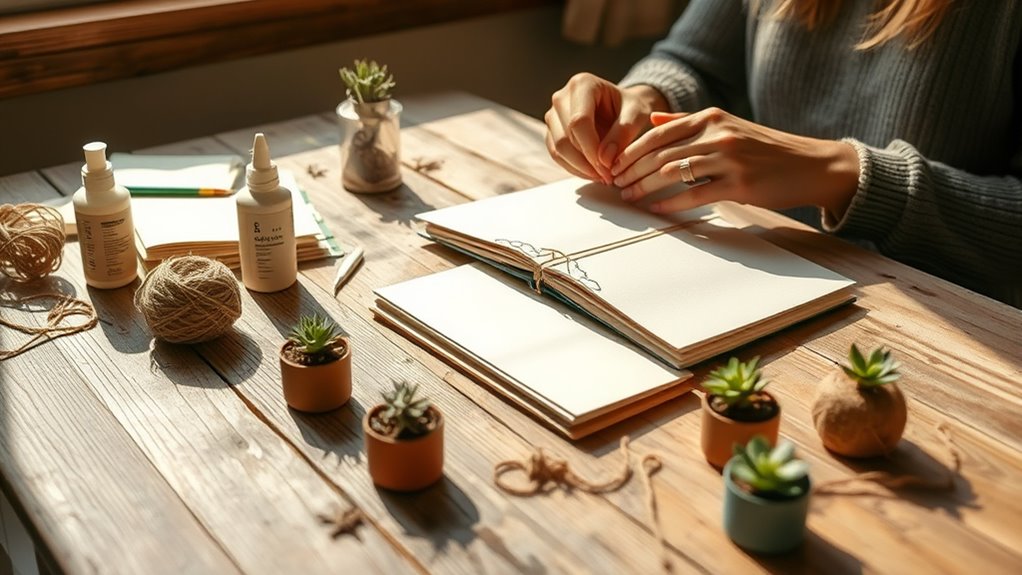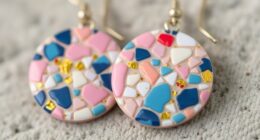To practice eco-friendly crafting with low-waste materials and habits, focus on using natural dyes instead of synthetic ones to reduce water pollution and chemical waste. Repurpose old tools and materials to minimize waste and add character to your projects. Plan your projects carefully to avoid excess supplies and choose sustainable, biodegradable materials whenever possible. Small changes like these can make a big difference, and exploring further will reveal even more eco-conscious tips to enhance your craft routines.
Key Takeaways
- Use natural, plant-based dyes to reduce water pollution and chemical waste in crafting projects.
- Repurpose and upcycle tools and materials to extend their lifespan and minimize landfill waste.
- Plan projects carefully to avoid excess materials and reuse scraps to promote waste reduction.
- Choose sustainable materials like organic fabrics and recycled papers for eco-conscious crafting.
- Incorporate mindful habits, such as using eco-friendly dyes and repurposing tools, into daily craft routines.

Have you ever wondered how your crafting habits impact the environment? Many traditional crafting methods involve wasteful practices and harmful materials, but there’s a growing movement toward eco-friendly crafting that minimizes your footprint. One key aspect is embracing sustainable dyeing techniques. Instead of using synthetic dyes that pollute water systems and contain harmful chemicals, sustainable dyeing employs natural, plant-based dyes or eco-conscious dyeing processes that reduce water and energy consumption. By choosing these methods, you not only create beautiful, vibrant projects but also contribute to less environmental harm. It’s a simple switch that makes a significant difference, especially when you pair it with upcycled tools. Properly maintaining your tools, such as bike components, can also extend their lifespan and reduce waste in your crafting process.
Upcycled tools are a fantastic way to extend the life of materials and reduce waste. Instead of buying brand-new supplies, you can repurpose items you already have or find discarded tools that still serve their purpose. For instance, old paintbrushes, worn-out scissors, or broken tools can be transformed into functional crafting aids. This approach keeps usable materials out of landfills and cuts down on resource extraction and manufacturing emissions. Using upcycled tools also adds a unique touch to your projects, giving each piece a story and character. Plus, it encourages a mindset of resourcefulness and creativity, prompting you to think outside the box about how to use what’s already available.
Repurpose old tools to reduce waste and add character to your craft projects.
Adopting these eco-friendly practices isn’t just about the tools and dyes. It’s also about cultivating habits that reduce waste overall. You can do this by planning projects carefully to avoid excess materials, reusing scraps whenever possible, and opting for packaging that’s biodegradable or recyclable. Choosing sustainable materials, like organic fabrics and recycled papers, complements your efforts and further lowers your environmental impact. Additionally, making your own supplies—such as natural dyes or upcycled tools—empowers you to control the entire process and ensures you’re using eco-conscious methods from start to finish.
Incorporating sustainable dyeing and upcycled tools into your crafting routine helps you develop a more mindful approach to creativity. It’s about more than just making beautiful objects; it’s about making a positive impact on the planet with every stitch, brushstroke, or cut. Each small change you make, from selecting eco-friendly dyes to repurposing tools, adds up over time. As you continue these habits, you’ll find that eco-friendly crafting becomes second nature—an integral part of your creative journey that benefits both you and the environment.
Frequently Asked Questions
How Can I Start Eco-Friendly Crafting With Limited Supplies?
You can start eco-friendly crafting by recycling old supplies and repurposing household items. Look around your home for materials like cardboard, jars, or fabric scraps, and think creatively about how to transform them into new projects. Use your imagination and focus on reducing waste. This way, you’ll craft sustainably, save money, and minimize your environmental impact, all while creating unique, eco-conscious pieces.
What Are the Best Sustainable Alternatives for Common Craft Materials?
They say “waste not, want not,” and that’s especially true in crafting. You should use recycled paper for your projects to reduce waste and choose biodegradable glues to keep your creations eco-friendly. These sustainable alternatives help lower your environmental impact while still allowing your creativity to flourish. Switching to these materials makes your craft more sustainable, proving that small changes can make a big difference in preserving our planet.
How Do I Dispose of or Recycle Craft Waste Responsibly?
To dispose of or recycle craft waste responsibly, start with craft waste reduction by carefully planning your projects to minimize leftover materials. Recycle craft supplies whenever possible, such as paper, cardboard, and certain plastics, by checking local recycling guidelines. Compost biodegradable waste like paper scraps and natural fibers. Avoid sending craft waste to landfills, and consider repurposing or donating unused materials to reduce environmental impact and promote sustainable crafting habits.
Can Eco-Friendly Crafting Save Me Money Long-Term?
Eco-friendly crafting can save you money long-term by reducing waste and optimizing your supplies. Use cost-saving tips like repurposing materials and buying in bulk. Maintaining eco-friendly tools, like sharpening scissors and cleaning brushes, extends their lifespan and prevents frequent replacements. These habits lower your overall expenses, making your craft projects more budget-friendly while benefiting the environment. Plus, you’ll enjoy a more sustainable crafting routine that saves money over time.
What Communities or Groups Support Sustainable Crafting Practices?
You’ll find vibrant communities supporting sustainable crafting through local workshops and online forums. Imagine a quilting circle where everyone shares scraps and tips, turning waste into art. These groups foster sharing, learning, and innovation, making eco-friendly crafting easier and more fun. Whether you join community workshops or participate in online forums, you’ll connect with like-minded crafters committed to reducing waste and making a positive environmental impact together.
Conclusion
By choosing eco-friendly crafting, you can turn everyday waste into beautiful creations without feeling overwhelmed. Sure, it might seem like small steps won’t make a difference, but imagine transforming scrap paper into stunning art or repurposing jars into charming vases—each piece a proof to your commitment. Every mindful habit adds up, helping the planet while fueling your creativity. So go ahead, craft confidently—your sustainable choices make a real, lasting impact.









